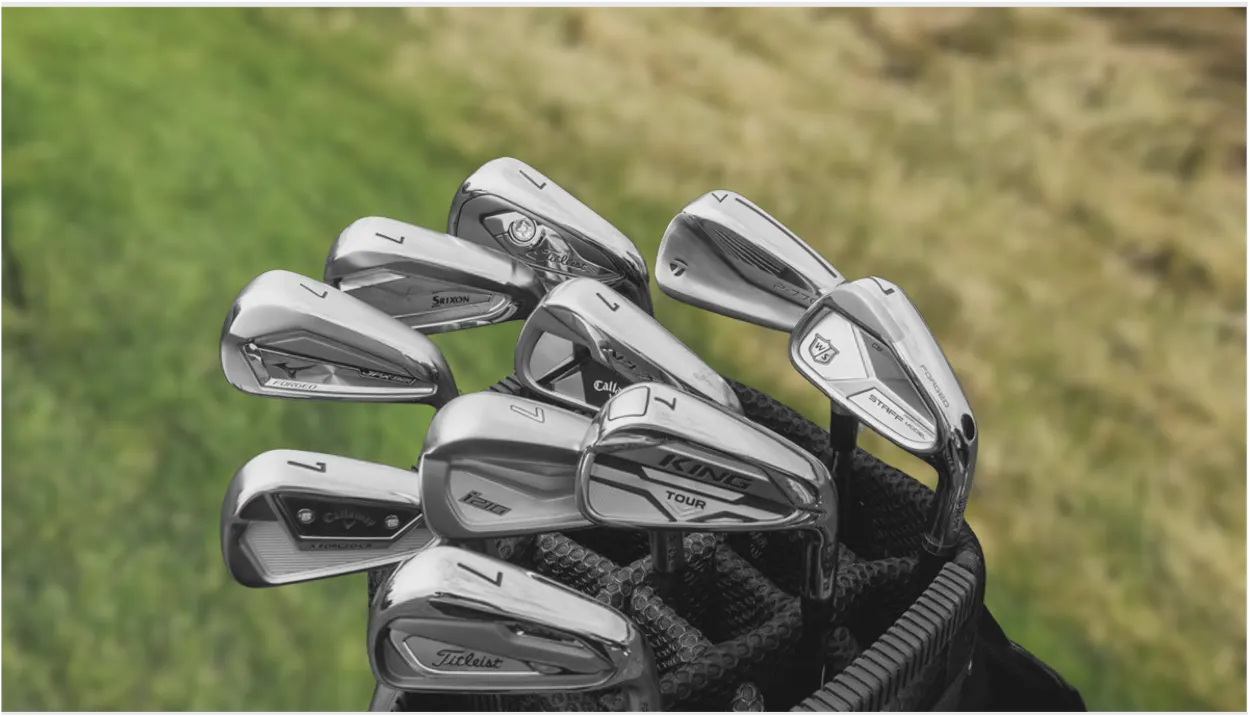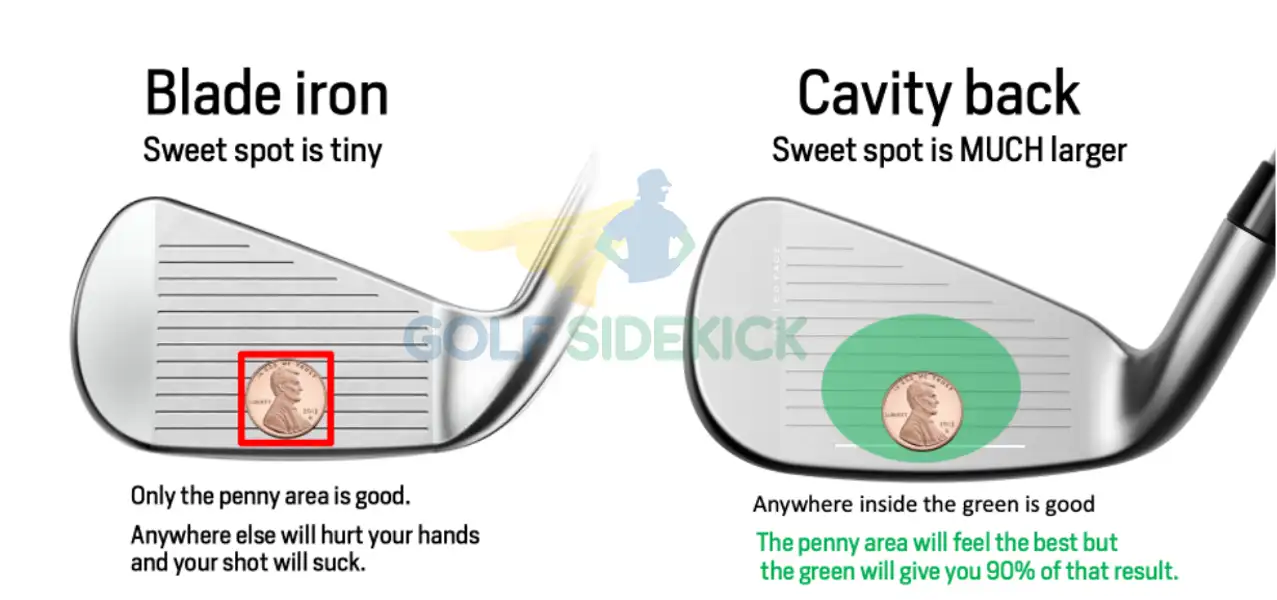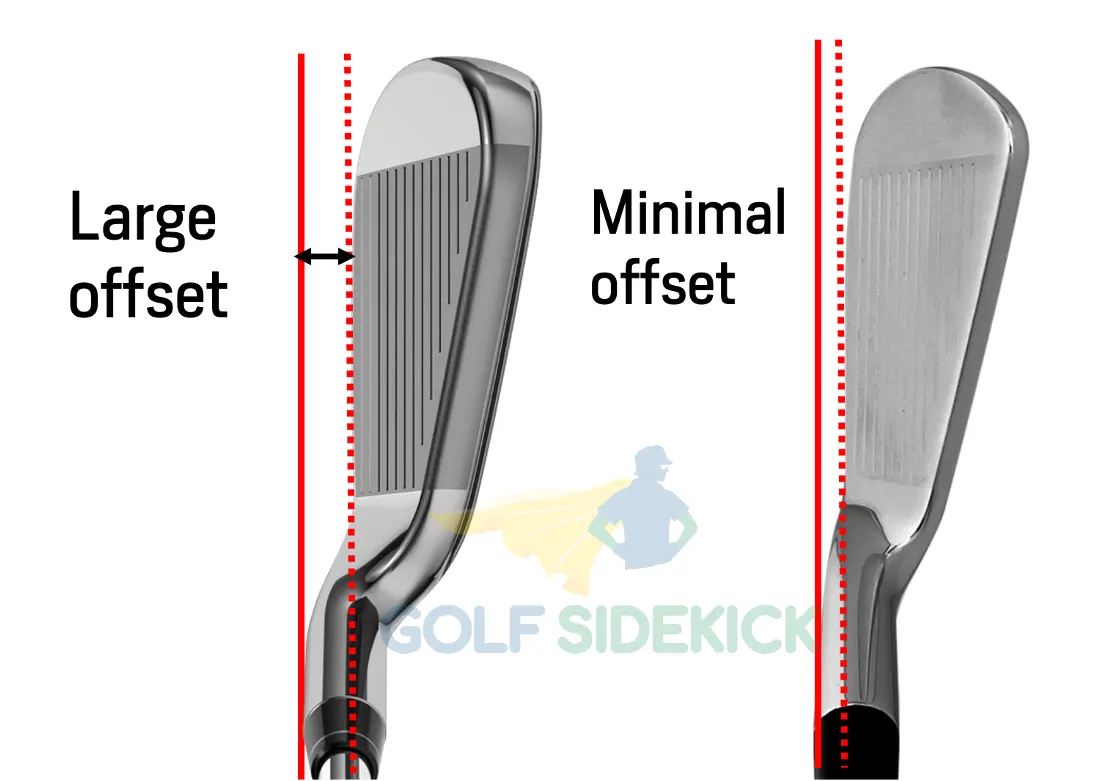Last Updated on February 4, 2024 by Matt Greene
Blade irons are generally golf clubs that pro golfers and low handicappers use. They provide more control of the ball flight than a cavity back for the skilled golfer, but are much less forgiving because of the small club head and tiny sweet spot.
Cavity back irons have a larger club head design to improve consistency when you miss the center of the club face. Club designers cut out a cavity in the back of the club and move the excess steel to the perimeter of the club head, increasing the size of the sweet spot, for extra forgiveness.
Cavity back irons usually have a wide sole, a big club face and some offset to make hitting the ball easier for every skill level especially golfers with higher handicaps. Blade irons have minimal offset, a thin top line and a very small club head.

Biggest differences between blade and cavity backs
The biggest difference you will notice when you hit a blade and cavity back is that a cavity back has much more forgiveness on off-center strikes.
Forgiveness
Forgiveness refers to the clubs ability to give you a relatively straight shot with decent distance even though you missed the center of the club face. Blade irons physically hurt you when you mis-hit them. You feel shockwaves through your hands and arms on off-center hits. You lose a lot of distance like this and the result of your shot is much worse than you planned.
Cavity back irons have a much bigger sweet spot than the blade, so if you miss the dead center of the face, it will steel feel quite good in your hands and arms. You can miss the sweet spot by a much bigger margin and still get a good result from your shot.
Why is it 'easier' to hit a cavity back?
The forgiveness of a golf club is determined by 3 important factors, working in unison to make a golf club easier to hit.
Forgiveness factor 1: Bigger sweet spot
Cavity back irons have a thin face with a lot of metal around the edges, called perimeter weighting. They originate from a blade iron, but the sweet spot on a blade iron is the size of a penny on the club face. You need to strike the ball within fractions of an inch of the sweet spot to hit a shot that feels good.
To make it easier to hit the clubs, designers drill out a cavity in the back of the club and place the extra materials that they remove, around the edges of the club instead which is called perimeter weighting. This creates a thinner club face (more trampoline-like) and lowers the center of gravity to make a more forgiving club. The sweet spot size is much bigger in a cavity back.

Forgiveness factor 2: Offset
On most cavity back irons, the heel and leading edge of the club is placed behind the hosel and shaft. The distance between the heel and the hosel is called the offset. Club manufacturers use offset to help golfers hit the golf ball with a square club face, improving the chances of a straighter flight.
The offset moves the club head’s center of gravity back from the shaft, which helps create a higher ball flight.

Most clubs will have a little offset, but you will find more offset in cavity back irons in the game improvement sets. The game improvement cavity backs are aimed at higher handicaps. As skill level and ball striking improves, you might find you need less offset to help you hit the ball straighter.
Forgiveness factor 3: Sole of the club
Blade irons have a very narrow and sharp sole. Golfers who play blades are expected to get the timing correct of the golf club entering the turf at the golf ball. If you hit the ground before the ball, the blade iron will dig into the ground. We call that a fat shot.
The cavity back irons often have much thicker, wider soles to prevent this digging. The bad shot for less skilled ball strikers is to hit fat shots. Wider soles on the cavity back irons prevent the digging that you find in blade irons.
You will find the biggest difference between the blade and cavity back sole-turf interaction on a golf course that is slightly wet. The blade will get stuck in the wet turf while the cavity back will glide through the ground without getting stuck.
Summary of iron forgiveness factors
| Factor | Cavity back irons | Bladed irons |
| Forgiveness | High | Low |
| Distance | Strongest | Low |
| Feel | Average | Best |
| Shot shaping | Low | High |
| Ball flight | High | Low |
| Player Handicap | Mid-Beginner | Low/Pro |
My Youtube video on cavity back and blade irons
My video has had over 100k views on this topic. Check it out below.
What is a cavity back iron?
Cavity back irons have a cavity in the back. When they put the excess materials around the edge of the club, the design keeps the club head more stable on off-center strikes.
The thicker and bulkier top line and sole of the cavity back are a more modern look than blades. Blades are very old school. Average golfers that don't hit the center of the club face should usually play cavity backs. The entire design of the cavity back is to help golfers launch the ball into the air easier, and have the ball fly further on all their shots.
There are two types of cavity back nowadays since more golfers want the forgiveness of cavity back and shot shaping ability of blades.
Game improvement cavity back
Game improvement clubs have very thick soles, very thick top lines and very thin club faces with a low center of gravity. The amount of offset is large on the GI irons.
Manufacturers place the center of gravity lower in a cavity back iron club head so the ball can fly higher but because of the higher flight, the loft of the cavity is often lower than the blade. That is the biggest surprise I found playing with game improvement cavity backs.
I KNOW that the loft is 30 degrees on a cavity back 7 iron but 34 degrees on my blade 7 iron. I hit the ball with both clubs, and the height of the shots are identical. That should not happen but the technology in a cavity back means it is possible.
Cavity backs sacrifice more control and shot shaping ability (not needed for 80% of golfers) for a bigger sweet spot, the ability to hit the ball higher and straighter, easier with maximum distance. But there is a second category of cavity back irons aimed at golfers who want the look and feel of a blade, with a touch of forgiveness.
Players cavity back
Not all cavity backs are aimed at high handicap or beginner golfers. There is a category called players cavity backs and they have been made for better ball strikers.
Players cavity backs have much less offset, a thinner top line and a thinner sole. There is a marked increase in forgiveness from a traditional blade. There are low to mid handicappers playing irons that look like blades but want to enjoy good shots on their mis-hits. The payers cavity back should be played by people who can hit the ball in the center 6-7 out of 10 times.
Who should play cavity back irons?
Almost every golfer over a scratch handicap 'should' play cavity back. A players cavity back will more then likely benefit a low handicap more than a set of blades. The main reason non-elite golfers play blades is ego.
If you struggle to hit the sweet spot, or you do not play regularly, cavity back game improvement irons are 100% recommended to enjoy golf to the maximum.
What is a blade iron?
Blade golf clubs are typically preferred by lower handicap golfers that can consistently hit the center of the club face. Please be aware that blades are also referred to in modern times as muscle back irons.
Blade irons are always forged from a single piece of metal. They have smaller club heads, thin soles and thin top lines - almost razor thin sometimes. There is a reason they are called blades. They look like knives!
A blade iron sacrifices forgiveness and instead promises a good ball striker, the ability to shape shots and control distance very effectively. Blades usually have 2-6 degrees more loft on the the club. A 7 iron in a cavity back set of irons might have 30 degrees of loft while in the blades, the loft of the 7 iron might be between 32 and 35 degrees.
Who should play blade irons?
PGA Tour pros, elite college golfers and low single digit handicap golfers will prefer blades. It is not completely based on handicap, but more on ball striking ability who should play blades. The key is to play blades only if you can hit the center of the face with consistency and regularity. I would estimate you should be able to hit the sweet spot at least 7 out of 10 times, preferably 8 or 9 times.
What is a split or blended set?
There are iron sets available that combine the precision of the blades with the forgiveness of the cavity backs. These sets usually contain BLADE 8 iron, 9 iron and pitching wedge. 7 iron, 6 iron and 5 iron in the blended set will be CAVITY BACK.
Most people have trouble hitting the longer irons (4-5-6-7), so these split sets help decent ball strikers to get the ball closer to the target with the longer clubs and be really mercenary on approach shots with the short irons.
When should you switch from cavity backs to blades?
Personally I changed from cavity back to muscle back blades when I was confident I could hit the center of the face 8 or 9 times out of ten. I was playing to a 5 handicap at the time and when i switched to blades, I dropped to a scratch handicap within a few months.
These factors will determine when to switch from cavity back to blades:
- You hit the center of the club face at least 7 out of 10 times
- Well struck cavity backs are not providing consistent distance control on approach shots
- You NEED to shape your golf shots (be honest with yourself if you really need to)
- Your turf conditions are firm and the wide soles of cavity backs is causing thin shots
- You are able to enter the turf at the golf ball, not behind the ball
When to NOT play blades
Do not listen to people who tell you that the only way to learn to hit the ball properly is with blades and that cavity back or game improvement irons will not help because they just cover up your flaws. These people do not know anything about golf.
The idea is to want to continue playing golf. How do you do that? You hit nice shots and feel good hitting them. Blades are very difficult to master especially at the beginning of your journey. First get the ball airborne, then do it a lot, and once you are super confident in the way you strike the ball, try blades. Keep in mind, that it may take years and years to get to that confidence level.
Why do I hit blades better than cavity backs?
The reason you might hit blades better than cavity backs is because you have excellent hand-eye co-ordination or excellent swing fundamentals. Usually people who have played bat-and-ball sports in their lives are able to find the sweet spot in almost any object. The blade iron is no exception and if you find that you hit blades better than cavities, you should play them until you find you no longer can.
There is no hard and fast rule that you MUST play one or the other. Use your best judgement that will create the most enjoyable golf for you.
Which are cast or forged irons?
Cavity backs are often cast irons which means liquid metal alloy is poured into a mould and left to set. You will most often find cast cavity back in the super game improvement iron category and beginner category. There are occasionally higher end models which are cast but it is rare. The feeling of a cast iron is often a bit firmer than the forged clubs but the sweet spots are always the same size - large.
Cavity back can also be made of forged steel which means the club is stamped out of a single piece of soft metal. They are usually the higher end models aimed more toward people who are playing regularly. Forged steel is much softer in feeling when you hit the golf ball. Regular golfers want a softer feel as they gain more experience on the course.
Note: If you need different lie angles in your irons, cast irons can be bent perhaps one time. If you bend the lie angle a second time, it will crack. Forged irons can be bent back and forth almost without limit. The steel is softer and malleable.
Blade irons are ALWAYS forged. They are often the most premium set in the ranges of the top manufacturers.
Summary
Thank you for allowing me to clarify the differences between blades cavity back irons. I would almost always recommend golfers play cavity backs but the choice is always yours. Take into account the things important to you on the golf course and you can't go wrong.
Just remember be honest with yourself, because you will be the golfer playing the clubs! Picking the right one should be easier for you now.
